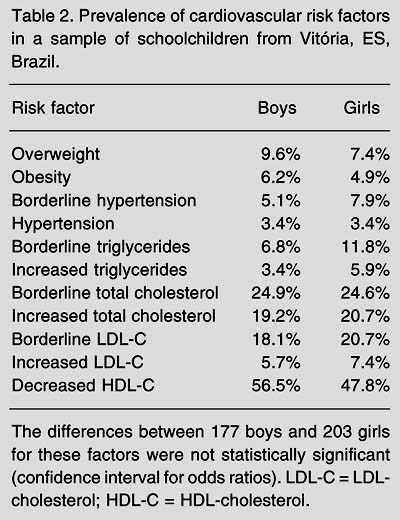Epidemiological and clinical evidence suggests that a judicious diet, regular physical activity and blood pressure (BP) monitoring must start in early childhood to minimize the impact of modifiable cardiovascular risk factors. This study was designed to evaluate BP and metabolic parameters of schoolchildren from Vitória, Espírito Santo State, Brazil, and correlate them with cardiovascular risk factors. The study was conducted on 380 students aged 10-14 years (177 boys, 203 girls) enrolled in public schools. Baseline measurements included body mass index, BP and heart rate. The students were submitted to exercise spirometry on a treadmill. VO2max was obtained from exercise testing to voluntary exhaustion. Fasting serum total cholesterol (TC), LDL-C, HDL-C, triglycerides (TG), and glucose were measured. Nine point nine percent of the boys and 11.7% of the girls were hypertensive or had pre-hypertensive levels. There was no significant correlation between VO2max and TC, LDL-C, or TG in prepubertal children, but a slight negative correlation was detected in post-pubertal boys for HDL-C and TG. In addition, children with hypertension (3.4%) or pre-hypertensive levels (6.6%) also had comorbidity for overweight and blood lipid abnormalities (14% for triglycerides, 44.7% for TC, 25.9% for LDL-C, 52% for low HDL-C). The present study shows for the first time high correlations between prehypertensive blood pressure levels and the cardiovascular risk factors high TC, high LDL-C, low HDL-C in schoolchildren. These are important for the formulation of public health policies and strategies.
Cardiovascular risk factors; Arterial hypertension; Primary prevention; Coronary artery disease; Obesity; Schoolchildren



